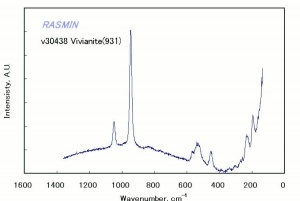Difference between revisions of "Ferrous phosphate"
Jump to navigation
Jump to search
| (One intermediate revision by one other user not shown) | |||
| Line 3: | Line 3: | ||
A hygroscopic, blue-gray powder that occurs naturally as the mineral [[vivianite]]. Vivianite was described after discovery in the St. Agnes mine in Cornwall in 1817. It has been called 'blue ocher' and has been found in Roman paint residues. Ferrous phosphate is used as a colorant in ceramics. | A hygroscopic, blue-gray powder that occurs naturally as the mineral [[vivianite]]. Vivianite was described after discovery in the St. Agnes mine in Cornwall in 1817. It has been called 'blue ocher' and has been found in Roman paint residues. Ferrous phosphate is used as a colorant in ceramics. | ||
| − | + | [[[SliderGallery rightalign|vivianiteRS.jpg~Raman]]] | |
== Synonyms and Related Terms == | == Synonyms and Related Terms == | ||
iron phosphate; vivianite; blue ochre; blue ocher; ocre de fer (Fr.) | iron phosphate; vivianite; blue ochre; blue ocher; ocre de fer (Fr.) | ||
| − | + | == Risks == | |
| − | + | * Slowly decomposes and darkens in light and air. | |
| + | * NIH: [https://pubchem.ncbi.nlm.nih.gov/compound/Ferrous-phosphate Safety sheet] | ||
| − | + | == Physical and Chemical Properties == | |
| − | Euhedral crystals with strong pleochroism from colorless to lilac blue. Strongly birefringent under crossed polars. | + | * Soluble in mineral acids. Insoluble in water. |
| + | * Euhedral crystals with strong pleochroism from colorless to lilac blue. | ||
| + | * Strongly birefringent under crossed polars. | ||
{| class="wikitable" | {| class="wikitable" | ||
| Line 25: | Line 28: | ||
|- | |- | ||
! scope="row"| Density | ! scope="row"| Density | ||
| − | | 2.58-2.68 | + | | 2.58-2.68 g/ml |
|- | |- | ||
! scope="row"| Molecular Weight | ! scope="row"| Molecular Weight | ||
| Line 33: | Line 36: | ||
| 1.60; 1.63; 1.65 | | 1.60; 1.63; 1.65 | ||
|} | |} | ||
| − | |||
| − | |||
| − | |||
| − | |||
== Comparisons == | == Comparisons == | ||
| Line 42: | Line 41: | ||
[[media:download_file_505.pdf|Characteristics of Common Blue Pigments]] | [[media:download_file_505.pdf|Characteristics of Common Blue Pigments]] | ||
| − | + | == Resources and Citations == | |
| − | |||
| − | == | ||
* Nicholas Eastaugh, Valentine Walsh, Tracey Chaplin, Ruth Siddall, ''Pigment Compendium'', Elsevier Butterworth-Heinemann, Oxford, 2004 | * Nicholas Eastaugh, Valentine Walsh, Tracey Chaplin, Ruth Siddall, ''Pigment Compendium'', Elsevier Butterworth-Heinemann, Oxford, 2004 | ||
Latest revision as of 12:50, 7 August 2022
Description
A hygroscopic, blue-gray powder that occurs naturally as the mineral Vivianite. Vivianite was described after discovery in the St. Agnes mine in Cornwall in 1817. It has been called 'blue ocher' and has been found in Roman paint residues. Ferrous phosphate is used as a colorant in ceramics.
Synonyms and Related Terms
iron phosphate; vivianite; blue ochre; blue ocher; ocre de fer (Fr.)
Risks
- Slowly decomposes and darkens in light and air.
- NIH: Safety sheet
Physical and Chemical Properties
- Soluble in mineral acids. Insoluble in water.
- Euhedral crystals with strong pleochroism from colorless to lilac blue.
- Strongly birefringent under crossed polars.
| Composition | Fe3(PO4)2.8H2O |
|---|---|
| CAS | 14940-41-1 |
| Density | 2.58-2.68 g/ml |
| Molecular Weight | mol. wt. = 357.48 |
| Refractive Index | 1.60; 1.63; 1.65 |
Comparisons
Characteristics of Common Blue Pigments
Resources and Citations
- Nicholas Eastaugh, Valentine Walsh, Tracey Chaplin, Ruth Siddall, Pigment Compendium, Elsevier Butterworth-Heinemann, Oxford, 2004
- Richard S. Lewis, Hawley's Condensed Chemical Dictionary, Van Nostrand Reinhold, New York, 10th ed., 1993
- R.D. Harley, Artists' Pigments c. 1600-1835, Butterworth Scientific, London, 1982
- The Merck Index, Martha Windholz (ed.), Merck Research Labs, Rahway NJ, 10th edition, 1983 Comment: entry 4101
- Art and Architecture Thesaurus Online, http://www.getty.edu/research/tools/vocabulary/aat/, J. Paul Getty Trust, Los Angeles, 2000

